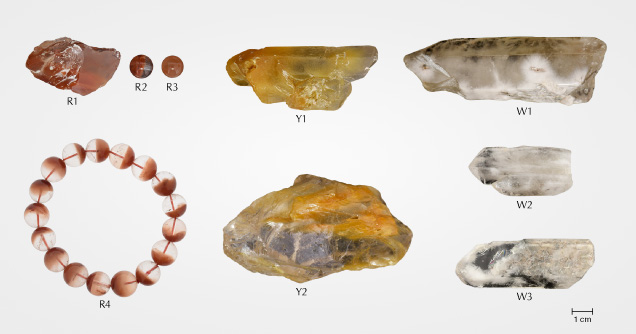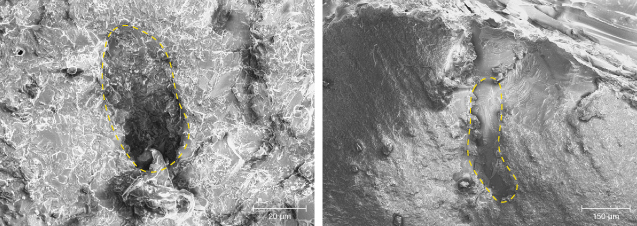Special Hair-Like Inclusions in Quartz

“Rabbit hair” quartz is a commercial variety of quartz with special inclusions. These inclusions resemble rabbit fur and are shorter and thinner than the typical rutile, tourmaline, or other acicular inclusions found in sagenitic quartz. To explore their internal features, nine rabbit hair quartz samples were classified according to the color of their inclusions (figure 1): red (R1–R4), yellow (Y1 and Y2), and white (W1–W3). The white rabbit hair quartz is rarer than the other colors.

Microscopic observation shows slight variation between the different colors of these hair-like inclusions. In the red rabbit hair quartz, massive curved red fibers are distributed evenly. They are mostly brownish red and less than 1 mm in length (figure 2A). The bright yellow needle-like inclusions are distributed regularly but with some localized disorder. Some of the disordered parts form divergent bundles (figure 2B). The white inclusions seem to be hollow tubes, measuring approximately 1–2 mm (figure 2C).
Raman analysis identified the inclusions in samples W1, R1, and Y2. The hollow tubes in sample W1 with peaks at 208, 266, 355, 405, 465, 810, and 1083 cm–1 are the characteristic peaks of quartz. The fibrous red inclusions in sample R1 with peaks at 246, 295, 412, 612, and 1319 cm–1 are hematite. The yellow inclusions in sample Y2 with peaks at 305, 394, and 694 cm–1 are goethite.

The freshly exposed surface of sample W1 was observed by scanning electron microscope (SEM). Figure 3 shows the secondary electron images; the pits are oblique sections of exposed hollow tubular inclusions (left), and the morphology of parallel sections of hollow tubes can be observed as grooves (right). In the pits, SEM with energy-dispersive spectrometry indicated that the main composition was SiO2, and no other impurity minerals filled into the hollow.
Fibrous hematite inclusions present in this study are rare in quartz, and their formation is likely related to the growth conditions (I. Sunagawa, Crystals: Growth, Morphology and Perfection, Cambridge University Press, Cambridge, 2005, p. 61). White hollow tubular inclusions might be the corroded product of hydrothermal fluids or weathering. In these processes, mineral inclusions were etched away, leaving the hollow tube with its original shape (Winter 2007 GNI, p. 370–373). However, the origin of yellow rabbit hair quartz still needs further research.



